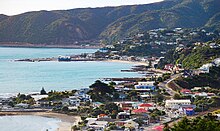Plimmerton
| Plimmerton | |
|---|---|
 |
|
| Basic information | |
| Local authority | Porirua |
| Population | 2,118 (2013 census) |
| Facilities | |
| Train station(s) | Plimmerton Railway Station |
| Surrounds | |
| North | Pukerua Bay |
| East | Camborne |
| South | Mana and part of Porirua Harbour |
| West | Porirua Harbour, then Cook Strait |
| Northwest | Hongoeka |
The suburb of Plimmerton lies in the northwest part of the city of Porirua in New Zealand, adjacent to some of the city's more congenial beaches. State Highway 1 and the North Island Main Trunk railway line pass just east of the main shopping and residential area.
Plimmerton has its modern origins as a late 19th Century seaside resort. It is named after John Plimmer, an English settler and entrepreneur who, through the Wellington and Manawatu Railway Company, helped to fund and direct construction of the railway line. Today, around 2,100 people reside in the suburb.
The area was first settled by the Māori people early in their occupation of New Zealand. Ngāi Tara and then Ngāti Ira settled south of Kapiti, and a number of other tribes may have lived in the area including Muaūpoko, Ngāti Apa, Ngāti Kahungunu and Ngāti Hotu.
Ngāti Toa people took control of the Porirua coast in the 1820s. In the 1840s the area where Plimmerton is situated was the home of Te Rauparaha, who had his main residence at Taupo Pa. Te Rauparaha was captured by 200 British troops and police on 23 July 1846 near the southern end of Motuhara Road. A tiny historic reserve contains a cabbage tree that may be descended from the one he was said to have been captured near, and a plaque. Over the next few years Taupo Pa was deserted and the main Ngāti Toa villages in Porirua became Takapuwahia and Urukahika.
The area was leased for farming by European settlers over the following decades. These included William Cooper, Canington (possible Carrington), and then Levi Tandy (from 1859). James Walker farmed from Paremata to Plimmerton beginning in 1875.
...
Wikipedia
